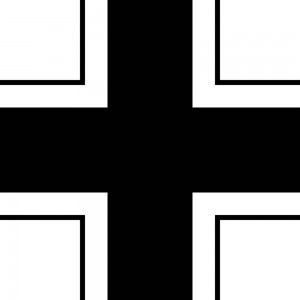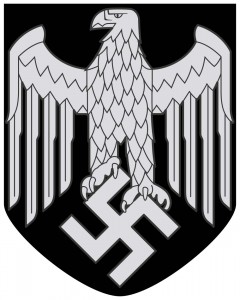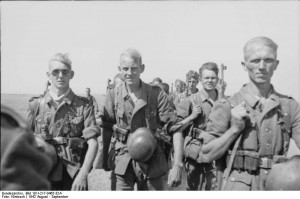 The Wehrmacht existed from 1935 to 1945 and consisted of the unified armed forces of Germany, including the Heer (army), Kriegsmarine (navy), and Luftwaffe (air force). The Luftwaffe actually had their own ground forces which included tank divisions. Although many people use the word “Wehrmacht” to specifically refer to the German army, originally, the word “Wehrmacht” meant to defend (wehren) and power or force (macht).
The Wehrmacht existed from 1935 to 1945 and consisted of the unified armed forces of Germany, including the Heer (army), Kriegsmarine (navy), and Luftwaffe (air force). The Luftwaffe actually had their own ground forces which included tank divisions. Although many people use the word “Wehrmacht” to specifically refer to the German army, originally, the word “Wehrmacht” meant to defend (wehren) and power or force (macht).
This German military force was used to launch offenses against enemy military targets, and to defend Germany when the country was attacked. The Wehrmacht officially began in 1935, and ended in 1945, with the Oberkommando der Wehrmacht (OKW) holding supreme command. When Germany surrendered after WWI, the Treaty of Versailles effectively disbanded their armed forces.
Schutzstaffel and Waffen-SS
Many high-ranking military members were members of the Schutzstaffel (SS) and Waffen-SS, which were the armed units of the SS. Waffen-SS field troops were under control of either the Oberkommando des Heeres (Army Supreme High Commander) or the Oberkommando der Wehrmacht (Armed Forces Supreme High Command).
The Waffen-SS was considered to be the Wehrmacht’s fourth branch, since it rapidly grew from three regiments to thirty-eight divisions by the end of World War II. Even though the Waffen-SS was independent and considered to be Adolf Hitler’s elite force, it did work concurrently with the Wehrmacht.
History of the Wehrmacht
 World War I officially ended November 11, 1918, with the signing of the armistice. In March of 1919, the German national assembly approved a law that would build a 420,000 preliminary army called the Vorläufige Reichswehr. In May of the same year, the conditions of the Treaty of Versailles had been released, and one month later Germany had to sign the treaty that imposed very severe constraints on the size of armed forces they were allowed. Another requirement of the Treaty of Versailles was the abolishment of general conscription or compulsory military service.
World War I officially ended November 11, 1918, with the signing of the armistice. In March of 1919, the German national assembly approved a law that would build a 420,000 preliminary army called the Vorläufige Reichswehr. In May of the same year, the conditions of the Treaty of Versailles had been released, and one month later Germany had to sign the treaty that imposed very severe constraints on the size of armed forces they were allowed. Another requirement of the Treaty of Versailles was the abolishment of general conscription or compulsory military service.
The Reichswehr
Germany’s army was restricted to only one hundred thousand soldiers while the navy was permitted an additional fifteen thousand men. The fleet was limited to six cruisers, six battleships, and twelve destroyers. The air force was eliminated and heavy artillery, tanks, and submarines were strictly forbidden.
On March 23, 1921, Germany instated the Reichswehr, their new post-war military. However, by the early 1920s, Germany began to secretly circumvent the restrictions of the treaty.
General Hans von Seeckt
The various limitations required by Versailles ended up being an advantage for Germany’s military. Since the Reichswehr was restricted to 100,000 men, the new commander of the armed forces, Hans von Seeckt, made sure that the military only kept the most desirable officers and soldiers. Seeckt selected only the best to be the new leaders for his general staff and ignored other constituencies, which included the nobility and many others.
Seeckt was determined that the Reichswehr would end up being an elite force that would function as the nucleus of Germany’s expanded armed forces once the opportunity for reestablishing conscription occurred. During the 1920s, Seeckt designed new doctrines that emphasized aggression, speed, and combined initiative and arms for lower ranking officers so they could benefit from the new training. Basically, this led to the development of a whole new army that was somewhat based upon the old army, but would be run very differently. In 1926, Seeckt retired but, the armed forces that went on to fight in 1939, had been mostly his creation.
Although Germany was not allowed to have a military air force, Seeckt, who understood the many advantages of having an air force, developed a clandestine elite group of air force military officers during the early part of the 1920s. Seeckt’s elite group of air force officers learned that the important role of the air force was to win air superiority, conduct strategic and precise bombing, and to provide any needed ground support. That the Luftwaffe failed to produce a strong strategic bombing force during the 1930s was not due to disinterest, but economic limitations.
Admiral Erich Raeder, who was a very close protégé of Grand Admiral Alfred von Tirpitz, was in charge of developing a new navy fleet. The naval officers that supported submarine warfare under Admiral Karl Dönitz’s leadership were mostly in the minority before 1939. However, after 1939, the submarine warfare program had become an important part of the navy.
Germany and Soviet Union Collaboration
After the Rapallo treaty was signed in 1922, Germany started a covert collaboration with the Soviet Union. Major-General Otto Hasse went to Moscow in 1923, in order to negotiate the collaboration terms. Germany assisted them with their industrialization plans, while Soviet officers were sent to Germany to receive training.
Many German air force and tank specialists were able to train in the Soviet Union. Germany’s chemical weapons manufacturing and research were also conducted there along with other military projects. Approximately, three-hundred German pilots received their training at Lipetsk, while tank training occurred near Kazan and different types of toxic gas had been developed at Saratov for Germany’s military forces.
Reinstatement of Conscription and Führer Adolf Hitler
Following President Paul von Hindenburg’s death on August 2, 1934, Adolf Hitler became the commander-in-chief of Germany. All of the officers and soldiers for Germany’s military were required to pledge their loyalty to the New Führer.
By 1935, Germany started to openly disregard most of the military restrictions established by the Treaty of Versailles, and reinstated conscription on March 16, 1935. The new conscription law was introduced with the name Wehrmacht. Therefore, March 16, 1935, is regarded as the Wehrmacht’s founding date. The official announcement of the Wehrmacht existence was announced on October 15, 1935.
Even though the scale of Germany’s standing army was required to be around 100,000 men, new groups of conscripts that were almost equal to that size started to receive military training every year after 1935. The authority and the organization of the Wehrmacht is viewed by many to be Nazi creations, in spite of the various political affiliations of the high command. The Wehrmacht’s insignia was based on the famous Iron Cross which had been widely used for tank and aircraft marking during the latter part of the First World War.
